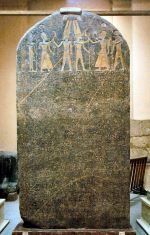Ask someone who is biblically literate how long Noah’s Flood lasted and the usual answer will be forty days and forty nights. But that is not quite right. The problem is that the Flood story consists of the intermingling of two different sources with different chronologies, tightly integrated by a subsequent redactor who may have made some additional changes. Scholars refer to these two sources as J (for Jahwist) and P (for Priestly). Unless otherwise indicated, I will rely on Richard Elliot Friedman’s Who Wrote the Bible for the identification of J and P texts within the Genesis Flood account.
One problem is that the Flood story consists of three phases, rising water, receding water, and drying of the earth, and there appear to be inconsistencies between J and P as to how these three events unfold. Let’s look at an example of some of the problems that have to be solved.
Genesis 7:4 says, “For in seven days I will send rain on the earth for forty days and forty nights.” Note here only rain is the source of the flooding. This verse belongs to the J source.
Genesis 7:6 says the Flood occurred during Noah’s six hundredth year but remains vague as to when in the six hundredth year the rain started. Genesis 7:11 says that on the seventeenth day of the second month of Noah’s six hundredth year “the fountains of the great deep burst forth, and the windows of the heavens were opened [emphasis added].” This verse belongs to P. Note here that the same day as the rain starts, there is both a downpour and the oceans burst open, a secondary source of the flooding.
Immediately after this last verse, Genesis 12–13 says, “The rain fell on the earth forty days and forty nights. On the very same day Noah with his sons, Shem and Ham and Japheth, and Noah’s wife and the three wives of his sons entered the ark [emphasis added].” This is a J passage. On what day did Noah and the family enter the ark? It could be argued that, given the narrative sequence, the family didn’t enter the ark until after the forty days of rain. But let’s put that issue aside. There are other problems.
The narrator is trying to give the impression that on the seventeenth day of the second month of Noah’s six hundredth year the rains started and Noah’s family entered the ark. Most scholars would probably agree that the J source flood story and the P source flood story commence at the same point in time. But is this the case?
The problem is when did Noah get the seven-day warning. If we add the seven-day warning to the forty days of rain in the J source and count from the first day of Noah’s six hundredth year, the elapsed time of 47 days falls on the seventeenth day of the second month of Noah’s six hundredth year, the same day that the P source sets as the start of its version of the flood story. (This would be true with solar or lunar calendars.)
So do we have one story where rain falls for forty days (J) and a separate story where rain falls and the oceans erupt on the same day (P) and did the redactor attempt to align them so that they started on the same day, or did he mean for the rains to fall for forty days, after which the oceans erupted and the rains continued beyond forty days?
There is no simple answer to this question and we have to do a deep dive into all of the chronological data in the Flood story to make sense out of the ways J and P interact. An important detail that helps us resolve the problem is that J and P use different time descriptions to move the story along.
J uses relative chronology and P uses fixed chronology. That is, in the J source, things happen after “D” number of days; in P, events happen precisely on specific dates, i.e., on day “D’ in month “M” in year “Y” thus and thus happened. In P you have to calculate to determine how many days elapsed between events and J tells you how many days elapsed between events. J, on the other hand, is not anchored to specific dates and P is anchored to specific dates. (Here, I would add that, in a couple of instances, Friedman assigns a couple of chronological references to the P source even though they have a J format. I will argue later that these references were added by the redactor in order to further the integration of the two sources.)
Over the next few posts on this topic, I will be looking at the J chronology in isolation from P; the P chronology in isolation from J; and the integration of the two. The chronological data will lead to interesting indications that the authors of J and P relied on differing aspects of the Egyptian calendar system for framing their narratives.


